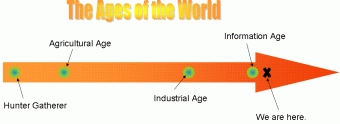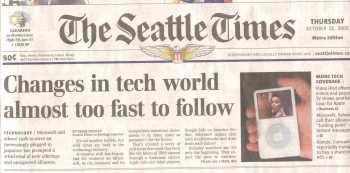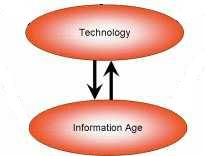Technology Integration - Part 1
Welcome to the Information Age!
The Information Age has implications for schools and their curricula.
The Information Age is the context for our schools, our students, and the technology in our classrooms.
For centuries, schools believed that their primary purpose was to transmit knowledge. The theories of education (pedagogy) involved how to best present facts and information so that students would understand and retain them. Then the Information Age happened.

We are now in the Information Age. Human history began (we humans started recording our history) in the Agricultural Age. We know that before humans settled down and started farming in one spot, they were nomadic, following migrations of game and finding fruits and grains along the way. The first civilizations were created in the Agricultural Age. We invented writing and math then.
The Industrial Age brought machines, engines, factories, and mass production on assembly lines. At the beginning of the Industrial Age, 95% of Americans were involved in agricultural work. By the end of the Industrial Age, only 1% of Americans were involved in agricultural work. Less than 1% of workers are farm workers now. (US Dept of Labor Bureau of Labor Statistics). These kinds of disruptions and changes are likely to happen to our population again with the Information Age. Imagine 90% of Americans retraining for new jobs.
What characterizes the Information Age? How is it different? The Information Age is characterized by 1) more and more information being created, 2) faster and faster media through which information can travel, 3) and more and more channels through which information can arrive. This results in “information overload.” In the past we were accustomed to having to “hunt” for information. Now, we find ourselves “blocking it out” or filtering it. There is simply too much information to deal with it all. This is a virtual explosion of knowledge.

Remember, for centuries education saw its primary purpose as the transmission of knowledge. The teacher knows everything and transmits the information to the student in the most efficient and effective way possible. The student in this scenario is the passive recipient of the knowledge.

It stands to reason that The Information Age (with more information, traveling faster, through more channels) should have some kind of profound effect on schools, right?
One effect of the Information Age is that we are forced into making choices about which information we will pay attention to. One is forced to decide which source of information to use when finding out what tomorrow’s weather will be. Or who won a particular basketball game last night. These decisions, whether conscious or not, require some sort of analysis (which information source is best for the situation I’m in right now? What does “best” mean right now?). The decisions also require some sort of evaluation based on the analysis. Analysis and evaluation are called “higher order thinking skills” on Bloom’s Taxonomy of Cognitive Functioning. The Information Age is forcing all of us to do more difficult, more complex, more demanding thinking to deal with the information overload.
In economics, the law of supply and demand says that when you have too much of something, demand goes down, the perceived value goes down. If there are too many cell phones for sale, the price of cell phones goes down. If we are drowning in information, drowning in knowledge, does that mean that the value of knowledge has been decreasing? Can schools be content to stick to transmitting knowledge in a world overloaded with knowledge? Are schools doing the equivalent of watering a garden in a torrential downpour?
How should K-12 education respond to the Information Age? How is K-12 education doing so far?
Let’s see … The normal K-12 school calendar is stuck in the … Agricultural Age. Do we really need to let the students stay home on the farm to help tend and get the crops in during the busy growing season of the summer?
K-12 schools are organized according to an Industrial Age model. Imagine the school is a conveyor belt on an assembly line. The students are “products”. The students/products encounter assembly specialists along the assembly line. The first specialists the “products” encounter on the assembly line are called Kindergarten teachers, then the conveyor belt moves the students up to the next assembly station, First Grade, where specialists continue the assembly. Keeping the students separated into same age groups leads to “industrial” efficiencies. This continues all the way up to 12th Grade. Often classroom desks are lined up in neat rows and columns (more industrial age thinking). What would an Information Age school look like?
Technology helped create the Information Age and IT can help cope with the Information Age.
Technology and the Information Age

In the diagram above, the Information Age is influencing Technology and Technology is in turn influencing the Information Age. There is a feedback loop working here. Information overload creates demand for technology to solve that problem. New technologies come on line that exacerbate the affects of the Information Age. The Information Age drive new technologies. New technologies drive the Information Age.
Computers were first developed to deal with information problems during wartime. Early computer use involved breaking codes and calculating anti-aircraft artillery trajectories. So, computers were invented to solve problems where the amount of information was large or the manipulation of information was tedious. The same technologies eventually permitted more information to be created through gathering data and crunching the data down to reveal patterns that were not normally visible. Computers allowed publishing to take off by making page layout simpler.
The same technology that makes creation and transmission of information easier also can be used as a tool to help us deal with the the information that has been created and transmitted (the information overload). Technology is adding to the problem and is also part of the solution of information overload.
To integrate technology into curriculum, one must understand both technology and curriculum.
The Information Age is driving changes in technology; technology is driving the Information Age.
The Information Age, school reform, and political efforts are driving curriculum change.
As curriculum changes, so does classroom practice.
As classroom practice changes, so does the manner in which technology may be used in the classroom.
The connection between technology and curriculum is information and information skills.
When the information in a unit of instruction is identified, opportunities for technology use are identified as well.
Coming faster – first modem (connection between computers) was 300 baud (300 bits per second = 27 words per second). The fastest modem now is 56,000 baud (56,000 bits per second = 7000 words per minute) and this is considered too slow to really use. DSL and cable modems run at 128,000 bits per second (at the slowest) to 1,500,000 bits per second. This is 10,000 times faster than the first modems!
More channels – how do you find out what tomorrow’s weather will be? How many possible ways are there? Newspaper, Radio, TV, Internet, phone call, cell phone, PDA (Blackberry).
Bloom's Taxonomy
Evaluation
Synthesis
Analysis
Application
Understanding
Knowing
“As things in the real world get more and more complicated and events happen faster and faster and information overload reaches tsunami proportions--people tend to treat facts the way they used to treat opinions. As a matter of choice.”
- Thomas Zengotita
Copyright 2006, 2007 T. Tobiason